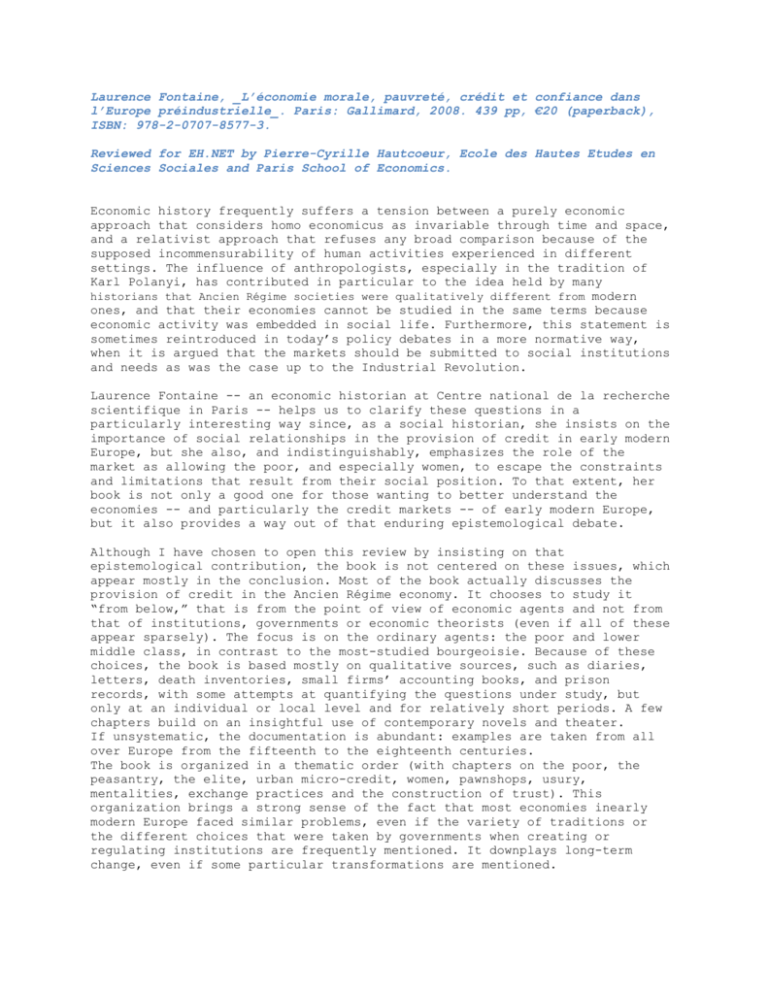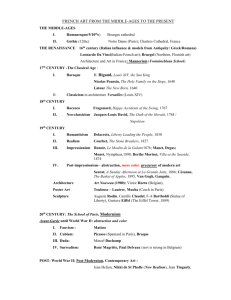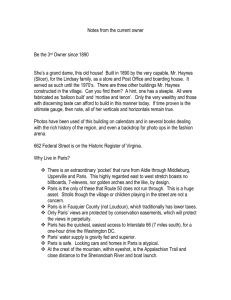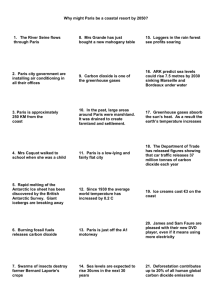
Laurence Fontaine, _L’économie morale, pauvreté, crédit et confiance dans
l’Europe préindustrielle_. Paris: Gallimard, 2008. 439 pp, €20 (paperback),
ISBN: 978-2-0707-8577-3.
Reviewed for EH.NET by Pierre-Cyrille Hautcoeur, Ecole des Hautes Etudes en
Sciences Sociales and Paris School of Economics.
Economic history frequently suffers a tension between a purely economic
approach that considers homo economicus as invariable through time and space,
and a relativist approach that refuses any broad comparison because of the
supposed incommensurability of human activities experienced in different
settings. The influence of anthropologists, especially in the tradition of
Karl Polanyi, has contributed in particular to the idea held by many
historians that Ancien Régime societies were qualitatively different from modern
ones, and that their economies cannot be studied in the same terms because
economic activity was embedded in social life. Furthermore, this statement is
sometimes reintroduced in today’s policy debates in a more normative way,
when it is argued that the markets should be submitted to social institutions
and needs as was the case up to the Industrial Revolution.
Laurence Fontaine -- an economic historian at Centre national de la recherche
scientifique in Paris -- helps us to clarify these questions in a
particularly interesting way since, as a social historian, she insists on the
importance of social relationships in the provision of credit in early modern
Europe, but she also, and indistinguishably, emphasizes the role of the
market as allowing the poor, and especially women, to escape the constraints
and limitations that result from their social position. To that extent, her
book is not only a good one for those wanting to better understand the
economies -- and particularly the credit markets -- of early modern Europe,
but it also provides a way out of that enduring epistemological debate.
Although I have chosen to open this review by insisting on that
epistemological contribution, the book is not centered on these issues, which
appear mostly in the conclusion. Most of the book actually discusses the
provision of credit in the Ancien Régime economy. It chooses to study it
“from below,” that is from the point of view of economic agents and not from
that of institutions, governments or economic theorists (even if all of these
appear sparsely). The focus is on the ordinary agents: the poor and lower
middle class, in contrast to the most-studied bourgeoisie. Because of these
choices, the book is based mostly on qualitative sources, such as diaries,
letters, death inventories, small firms’ accounting books, and prison
records, with some attempts at quantifying the questions under study, but
only at an individual or local level and for relatively short periods. A few
chapters build on an insightful use of contemporary novels and theater.
If unsystematic, the documentation is abundant: examples are taken from all
over Europe from the fifteenth to the eighteenth centuries.
The book is organized in a thematic order (with chapters on the poor, the
peasantry, the elite, urban micro-credit, women, pawnshops, usury,
mentalities, exchange practices and the construction of trust). This
organization brings a strong sense of the fact that most economies inearly
modern Europe faced similar problems, even if the variety of traditions or
the different choices that were taken by governments when creating or
regulating institutions are frequently mentioned. It downplays long-term
change, even if some particular transformations are mentioned.
As is typical of any book dealing with such a large period and space, it is
mostly based on a large -- indeed impressive -- bibliographical base (30
pages of references, mostly in English, French and Italian, with occasional
Dutch, German and Spanish). It is, perhaps more importantly, based on
Fontaine’s experience studying the poor and migrants (especially peddlers) of
early modern Dauphiné and Savoie.
The first important result of the book is to show that credit was not only
developed among the well-to-do in early modern Europe (as shown for example
by Hoffman, Postel-Vinay and Rosenthal in _Priceless Markets_).
It was a daily part of the “survival strategy” of the poor, more important,
indeed, than the help provided by charitable institutions.
Most of the working poor needed credit in order to start or to keep their
small businesses running in the face of accidents, delays, illness, and lifecycle events -- and this was true as much in the countryside as in the
cities. Fontaine shows that the few remaining traces suggest that oral credit
was ubiquitous, that written credit was much more frequent than what is
observed in notaries’ archives (because of the cost and delay of their
certification), and that a majority in the population died with negative
assets -- that is, unpaid debts superior to their belongings.
Credit was organized in various circles, starting from the closest relatives
(the family and neighbors), social authorities (the lord, notables),
institutions (guilds, pawnshops) and, lastly, foreigners -- as most
moneylenders were considered (either Lombard, Savoyard or Jew).
Except for very small amounts, credit among equals (or relatives) – was
rarely much of a resource for the truly poor ... because their relatives were
poor too, and also because even “family solidarity is everything but natural”
(p. 36). Actually, such solidarity could only result from a well-organized
community, which was able to constrain the borrower.
Therefore most of the credit to the poor came from notables, institutions and
moneylenders.
Among these, the lords were probably those with the most specific behavior in
the Ancien régime. They frequently lent substantial amounts to their vassals,
especially to their farmers. These debts were seldom reimbursed, and mostly
implied yearly payments (which could be in kind).
They could be restructured when either the lender or the borrower left or
died, and parts of them could even be abandoned gracefully in periods of
hardship. Fontaine argues that these debts were part of a broader social
relationship, which explain both that the lords had to lend in order to
maintain status and reputation even when reimbursement was anticipated as
almost impossible, and how they were able to force payments for long periods,
thanks to their local power.
Aristocrats actually reciprocated downward the relationships based on
political dependence they suffered towards the princes to whom they
forcefully lent and asked for privileges or rents as payments. When in debt
(and they were frequently so), they dismissed and ill-treated their
moneylenders (who always suffered bad treatment if they tried to obtain
payment through legal means), except those who had been able to access some
personal secrets, as was frequently the case when wives pawned their jewelry
to old women lenders (the marchandes à la toilette made famous by novelists
down to Balzac). On the other hand, aristocrats considered their gambling
debts as the only serious ones because they were purely personal, among
equals, and a symbol of their lives’
dedication to risk and gratuitousness.
At the opposite end of the social spectrum, poor women had no power and a
precarious status. Fontaine shows that the legal position of women mostly
deteriorated in much of Europe in the early modern period, obliging them to
participate in the most informal and unsecured credit markets. However, her
conclusion is not that the market was dangerous to women, but quite the
opposite, since where women started participating in markets, they ended up
not only surviving, but even obtaining some recognition, as merchants if not
as wives: “Everywhere and since the Middle Ages, the development of markets
boosted the legal autonomy of women” (p.144).
Credit was then not limited to the world of the merchants, as often
described, but penetrated, although unevenly, all classes of society. As
early as the first half of the sixteenth century, Rabelais could write that
“nature created man only to lend and borrow.” Usury laws were unable to
restrict the ubiquity of credit, as the Church actually abandoned applying
them as early as the sixteenth century. At that time, the states took over
the issue and maintained or reinforced usury laws, but let develop a
jurisprudence which allowed for many exceptions and by-paths.
Credit was ubiquitous and diverse, but Fontaine argues that its diversity can
be better understood using a bipolar lens. Step by step, her book builds a
representation of the credit market that distinguishes two ideal-types of
credit relationships. These two ideal-types are clearly delineated in chapter
8 thanks to the use of Shakespeare (_Timon of Athens_ and _The Merchant of
Venice_), Molière and the _Tableau de Paris_ by Louis-Sébastien Mercier. The
first one is “aristocratic” the second one “merchant.”
In the aristocratic world, credit relationships are embedded in social
relationships and religious imperatives: interest is frequently hidden or in
kind, or even disguised in voluntary gifts, debts have no definite term or
can be prolonged indefinitely, the relationship between debtor and creditor
is statutory or personal. In the merchant world on the other hand, the
contract is precisely defined and respected thanks to strong guarantees, and
the relationship is impersonal or among equals thanks to a strong role of the
law. If this distinction is similar to the one usual among anthropologists,
Fontaine’s claim is actually very
different: first because she argues both types of relationships co-existed
permanently (even if their relative importance varied) and most people could
enter both types of relationships, choosing with whom to contract. Second
because the market was not intrinsically less humane than the personal
relationship: if less open to credit restructuring for personal reasons, it
was more rule-based and thus more protected against the creditor’s power. So
individuals chose both what type of relationship they wanted to enter and
with whom to enter it. They, usually, had some choice, and the social
environment, although constraining, was also a space of opportunities.
Even more important, Fontaine shows that the aristocratic and the merchant
economies not only conflicted but also penetrated each other.
Chapter 6 is very illuminating in that respect, showing that pawnshops (monte
di pieta) were invented in the early fifteenth century by Franciscans wanting
credit to become a complement to charity, one through which the poor could
get more autonomy and capacity to exert their talents, although escaping the
dangers of usury and over-indebtedness.
The last chapter on the social construction of credit provides the reverse
example: while Franciscans accepted the role of credit markets in helping the
poor, merchants never entirely rejected some “aristocratic” dimension of
credit. Analyzing bankruptcies and the relationships among merchants in hard
times, Fontaine shows that they appealed to the community to which they
belonged, and obtained help as long as they were truly integrated into it,
much like in the aristocratic economy.
The book then concludes that both market and personal relationships were
always present in early-modern credit, but focuses mostly on the role of the
market in allowing the emancipation of the poor and the development of their
capabilities, in an explicit reference to Amartya Sen.
Although I had great pleasure in reading this convincing and powerful book, a
few critical remarks must be added. First, although the book’s approach
encompasses many topics, some important ones are missing. The practices and
culture of credit among merchants is given little place.
This is certainly intended as a necessary correction in view of its excessive
place in the previous literature, but the correction is probably also
excessive. Public credit is also absent, to some extent in contradiction with
the author’s very views on the relationships between princes and some of
their aristocratic creditors. Maybe most importantly, this is a history with
little historical change. As mentioned earlier, some changes are mentioned in
various chapters, but no answer is given to the most important question: if
there was a substantial change in the way credit markets worked from the
sixteenth to the nineteenth centuries, what was that change and where did it
come from? The author could have linked the emancipation towards the power
element in aristocratic relationships with the development of legal and
representative institutions; nevertheless, law is little present except in
the chapter on women, and politics is altogether absent. Finally,
contemporary economic thought and modern theory are absent. Both have
nevertheless proved to be useful in order to understand early modern
economies (see e.g. Grenier’s _L’économie d’Ancien Régime_ as an attempt
based on contemporaries). Fontaine actually uses some concepts from imperfect
information theory, but quite clumsily. These remarks suggest that an even
broader synthesis would be welcome in order to provide a truly comprehensive
view of early modern credit.
Some of the book’s arguments are not well presented, and would have gained
from better writing. The author frequently makes the point that personal
debts were extended for long periods, but does not relate this clearly to the
annuities model which was so dominant in farming and public debt in the
period. Over-indebtedness is forcefully asserted, but insufficiently
demonstrated in economic terms, since payment flows should be related to
incomes rather than volumes of debts to assets.
More seriously, the author argues that the fact that the poor invested all
their income in clothes or jewelry reflected a “preference for illiquidity”
(e.g., p. 132), when actually these goods were chosen because they were
highly liquid (thanks to the pawnshops the author describes so well), and
were given preference over money because of the riskiness of money that could
be stolen or be forcefully borrowed by relatives.
Other remarks are more formal. Although the book is quite beautiful, it is
not well edited. Chapter two is somewhat repetitive of chapter one, some
developments (e.g. on women’s legal status on pp. 134-56) are too long and
are not well integrated into the general story. A more careful reading by the
publisher would also have avoided the repetition of entire sentences (pp. 164
and 165, pp. 185, 186 and 189, pp. 244 and
265) or quotes badly cut (p. 172).
In spite of these small shortcomings, this book remains an impressive
synthesis and a brilliant essay. One should hope that it will be rapidly
translated into English in order to get the wider readership it deserves.
References:
Jean-Yves Grenier, _L’économie d’Ancien Régime: un monde de l’échange et de
l’incertitude_, Paris, Albin Michel, 1996.
Philip T. Hoffman, Gilles Postel-Vinay, and Jean-Laurent Rosenthal,
_Priceless Markets: The Political Economy of Credit Markets in Paris, 16601870_, University of Chicago Press, 2001.
Pierre-Cyrille Hautcoeur is Professor of economics at Ecole des Hautes Etudes
en Sciences Sociales and Paris School of Economics, Paris. His recent
publications include _Le marché financier français au 19e siècle_, Paris,
Publications de la Sorbonne, 2007, the edition of a special issue of
_Histoire et Mesure_ on bankruptcies, "Bankruptcy Law and Practice in 19th
Century France," in _Insolvency and Bankruptcy
Laws: Issues and Perspectives_ (JAI University Press, 2008) and "Why Didn't
France Follow the British Stabilization after World War One?"
(with M. Bordo), _European Review of Economic History, 2007.
Copyright (c) 2009 by EH.Net. All rights reserved. This work may be copied
for non-profit educational uses if proper credit is given to the author and
the list. For other permission, please contact the EH.Net Administrator
(administrator@eh.net). Published by EH.Net (January 2009). All EH.Net
reviews are archived at http://www.eh.net/BookReview.











